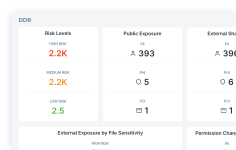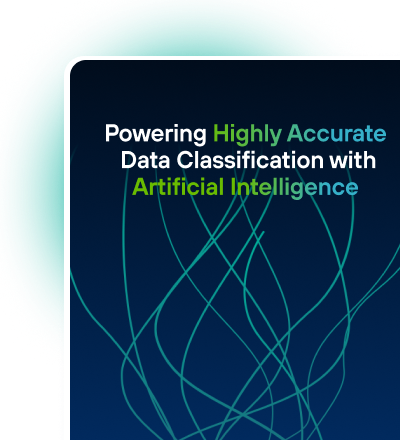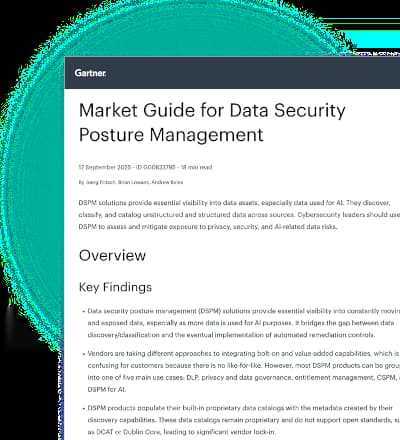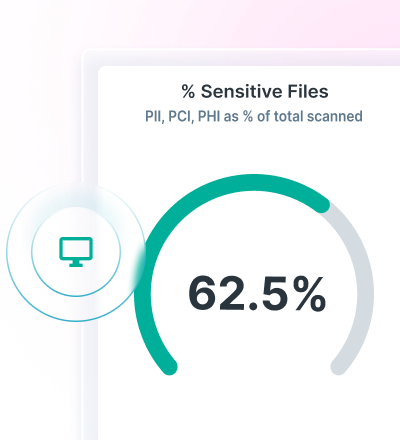Complete Guide to Data Access Governance for Modern Enterprises
0 min read

Lionel Menchaca
Data Access Governance (DAG), in simple terms, is the discipline of managing who can access your sensitive data, where that data lives and how that access is used – across your entire enterprise. In this guide you’ll learn why DAG matters, how it works and how to build a successful program.
What Is Data Access Governance (DAG)?
Data Access Governance (DAG) is the discipline of managing who has access to sensitive data, where that data resides and how that access is used across the organization. It provides the structure and visibility needed to eliminate unauthorized exposure, reduce insider risk, prevent data loss and simplify compliance.
At its core, DAG ensures that access to information aligns with business needs and security policies. It is a critical layer within a broader data security ecosystem that includes data security software such as Data Security Posture Management (DSPM), Data Detection and Response (DDR), Data Loss Prevention (DLP) and Cloud Access Security Broker (CASB) tools.
Together, these capabilities close the long-standing visibility and control gap by giving organizations the power to see sensitive data, understand its context, and manage who can access it. Effective DAG ensures that every access decision is both intentional and explainable, strengthening security and compliance readiness across the entire data landscape.
Why Data Access Governance Matters
Enterprises today manage more data in more places than ever before, a trend accelerated by the rise of the hybrid workplace. Sensitive information now lives in databases, cloud apps, shared drives and collaboration tools that change daily. Without consistent governance, visibility erodes. Employees accumulate excessive permissions, and external users may retain access long after projects end.
The result is an expanding risk surface that attackers, insiders and auditors will all notice. Weak access governance increases the likelihood of a breach, complicates investigations, and undermines compliance with global regulations such as GDPR, HIPAA, ISO 27001 and others.
Without automation, manual audits and compliance reporting are time-consuming and error-prone, while siloed tools create gaps in protection and response.
Challenges for Data Access Governance
Organizations face several obstacles when trying to implement and maintain effective Data Access Governance, particularly as data environments grow more complex and distributed.
- Data Growth and Sprawl: Rapid expansion of cloud, SaaS and collaboration platforms scatters data across environments, making it difficult to identify and govern consistently.
- Excessive and Unmanaged Permissions: Users often accumulate permissions they no longer need, creating hidden access pathways that increase security risk.
- Hybrid and Multi-Cloud Complexity: Different platforms use unique access models and permission structures, complicating unified governance across the enterprise.
- Limited Data Context and Classification: Without knowing which data is sensitive or who owns it, organizations struggle to enforce appropriate access controls.
- Manual Access Review Burden: Periodic access certifications are time-consuming and error-prone when performed manually, leading to reviewer fatigue and compliance gaps.
- Lack of Real-Time Access Visibility: Delayed or incomplete monitoring allows anomalous or risky access behaviors to go undetected.
- Cross-Team Misalignment: Security, IT and business stakeholders often operate in silos, resulting in inconsistent governance processes and unclear accountability.
- Evolving Regulatory Requirements: Constantly changing privacy, security and data usage regulations require organizations to maintain flexible, audit-ready governance practices.
Benefits of Data Access Governance
Effective Data Access Governance (DAG) provides organizations with much more than basic access control. By establishing clear visibility, accountability and control over how data is accessed, shared and used across the enterprise, organizations can significantly strengthen their security and compliance posture while enabling safer productivity.
1. Enhanced Data Visibility and Context
DAG provides unified visibility into who has access to what data and why. With this context:
- Security teams can identify excessive or unnecessary permissions
- Data owners can make more informed access decisions
- Organizations reduce the likelihood of “shadow access” that often goes unnoticed
2. Stronger Security Through Least-Privilege Access
A core benefit of DAG is the ability to enforce least-privilege access at scale. By continuously monitoring permissions and ensuring users only have access they truly need:
- Attack surfaces shrink dramatically
- Insider threats and compromised account risks are reduced
- Lateral movement becomes significantly harder for adversaries
3. Streamlined Compliance and Audit Readiness
Regulations like GDPR, HIPAA, PCI DSS and emerging AI data standards require organizations to demonstrate control over sensitive data. DAG helps by:
- Providing auditable records of access changes and approvals
- Automating periodic access reviews
- Offering a consistent policy framework across hybrid and multi-cloud environments
4. Improved Operational Efficiency
Manual access reviews and permissions clean-ups are time-consuming and error-prone. DAG automates large portions of these processes, enabling:
- Self-service access workflows with proper guardrails
- Faster onboarding and role changes
- Reduced burden on IT and security teams
5. Reduced Risk of Data Breaches
Many data breaches stem from over-permissioned accounts or unmanaged data access paths. DAG reduces these risks by:
- Detecting anomalous or high-risk access patterns
- Eliminating unused privileges over time
- Providing real-time alerts when access violates policy
6. Better Alignment Between Security and Business Teams
With DAG, organizations can clearly define data ownership, approval workflows and usage policies. This leads to:
- Stronger collaboration between IT, security and line-of-business teams
- Faster decision-making backed by shared visibility
- Improved governance maturity across the organization
Core Components of Effective Data Access Governance
The foundation of DAG rests on three guiding principles: visibility, control and accountability.
1. Visibility means knowing what sensitive data exists and who can access it. Discovery and classification form the starting point of every governance initiative.
2. Control ensures that only the right people have the right level of access at the right time, an essential Zero Trust concept.
3. Accountability provides continuous oversight, tracking how data is used alerting on anomalies and offering defensible evidence of compliance.
When aligned with frameworks such as NIST, ISO 27001 and Zero Trust, DAG creates a durable foundation for long-term risk reduction.
How Data Access Governance Works
An effective Data Access Governance (DAG) program connects executive leadership, compliance experts, and security operations around a unified strategy to protect sensitive data and reduce risk.
Executive Leadership (CIO, CFO, CDO):
- Define the vision, allocate resources, and monitor business outcomes. Their focus is reducing data risk while maintaining agility and ensuring DAG investments deliver measurable ROI.
Governance, Risk, and Compliance (GRC) Teams:
- Translate regulations and risk frameworks into actionable access policies. Use Forcepoint DSPM and DLP to automate classification, enforce consistency and streamline audits and attestations.
Security Leadership (CISO, VP, or Director of Security):
- Oversee DAG implementation and align it with Zero Trust and corporate security goals. Use Forcepoint DSPM, DDR, DLP and CASB to unify visibility, detection and enforcement across the data landscape.
Security and IT Practitioners:
- Manage permissions, monitor access, and respond to incidents. Leverage Forcepoint automation to maintain least-privilege access and reduce manual workload through policy-driven controls.
Cross-Functional Collaboration:
- Regular reviews connect leadership, compliance and operations teams to align on risk and priorities. Shared dashboards in Forcepoint Data Security Cloud keep everyone working from the same data insights, turning governance into a continuous, adaptive process.
Key Use Cases for Data Access Governance
Every organization faces its own version of the access challenge. Common Data Access Governance use cases include:
- Regulated data protection: Control access to PII, PHI and payment data to meet GDPR, HIPAA and PCI DSS.
- Intellectual property defense: Restrict access to design documents, source code and research data to prevent insider or competitor leaks.
- Collaboration platform governance: Enforce permissions in platforms such as SharePoint, OneDrive and Google Workspace.
- Third-party and M&A governance: Review and adjust access rapidly when integrating partners or business units.
- Hybrid and multi-cloud environments: Maintain consistent controls across AWS, Azure, GCP and SaaS.
These scenarios and more use cases show why DAG is more than a compliance checkbox. It is a strategic enabler for secure digital transformation.
Data Access Governance in the Cloud
As enterprises shift workloads to the cloud, the perimeter dissolves. Data now lives across SaaS, IaaS and collaboration ecosystems that change hourly. Cloud Data Access Governance (Cloud DAG) extends traditional controls to wherever data resides.
Forcepoint CASB plays a pivotal role by discovering unsanctioned applications, monitoring data movement in SaaS tools and enforcing access policies in real time. By connecting CASB with DSPM for data discovery and DLP for policy enforcement, organizations gain unified visibility and control over cloud data.
Forcepoint Data Security Cloud delivers this full integration, combining CASB, DSPM, DLP and DDR to provide end-to-end visibility and automation. This shared-responsibility model ensures both provider and customer sides remain protected.
Best Practices for Data Access Governance Success
Security and compliance teams emphasize the same core success factors when approaching best practices for Data Access Governance:
1. Establish ownership early. Define clear roles for data owners, security teams, and auditors.
2. Start with discovery. You cannot govern what you cannot find.
3. Adopt least privilege by design. Regularly review access and remove unused permissions.
4. Automate wherever possible. Use policy-based automation for routine reviews.
5. Maintain human oversight. Keep manual review for exceptions or high-risk assets.
6. Continuously adapt. Align policies with changing data patterns and business needs.
Following these steps moves organizations from reactive cleanup to proactive, sustainable governance.
Essential Data Access Governance Tools
The right Data Access Governance tools can automate a program by combining discovery, classification, monitoring and enforcement. Forcepoint does this within a unified platform, Forcepoint Data Security Cloud.
- Forcepoint DSPM automatically scans and classifies data across cloud and on-premises systems using AI Mesh to identify sensitive data types accurately.
- Forcepoint DDR continuously monitors data access patterns, flags excessive permissions, and prevents breaches from over-permissioned files.
- Forcepoint DLP and Risk-Adaptive Protection enforce least-privilege policies and trigger automated responses to policy violations.
- Forcepoint CASB extends this protection to SaaS environments, providing real-time visibility and control over data movement in cloud applications.
Together, these capabilities operationalize Data Access Governance and reduce compliance risk through continuous monitoring and remediation. Within Forcepoint’s architecture, DSPM provides visibility, DDR automates detection and response, DLP enforces policy and CASB extends those controls to the cloud.
When combined, they form the foundation of Forcepoint’s Data Access Governance solution, delivering end-to-end protection and compliance for data wherever it resides.
Comparing Data Access Governance Solutions
The DAG vendor market includes both legacy identity-focused tools and modern, AI-driven platforms.
When evaluating Data Access Governance solutions, prioritize:
- Depth of visibility: Can it reveal data sensitivity and ownership across hybrid and cloud environments?
- Automation and AI: Does it intelligently classify data and adjust access dynamically?
- Scalability: Can it govern millions of files and identities efficiently?
- Integration: Does it connect DSPM, CASB, DLP and DDR for end-to-end governance?
While Data Access Governance vendors like Varonis and SailPoint focus mainly on identity governance, Forcepoint delivers unified DAG that extends visibility and control through DSPM, CASB, DLP and DDR. This integrated approach closes the loop between discovery, policy and enforcement while reducing both risk and operational complexity.
The Future of Data Access Governance
DAG is evolving alongside AI-driven environments. Generative AI and agentic AI introduce new access risks as autonomous systems interact with data on behalf of users. Organizations must now monitor both human and machine-driven access.
Next-generation governance will rely on self-aware data security, where sensitive data recognizes its own classification and applies controls dynamically. The AI Mesh technology that powers Forcepoint DSPM exemplifies this shift, using federated learning to classify and protect data in place without moving or exposing it.
This evolution marks a turning point. DAG is no longer a static permission model but a dynamic intelligence layer that adapts to how data is created, shared, and used.
Start Your Data Access Governance Journey
We’ve started by answering the question, “What Is Data Access Governance?” and have walked through key concepts such as core principles, best practices and use cases.
By now you understand that Data Access Governance is no longer optional. It is foundational. By aligning visibility, control and accountability, organizations can confidently manage sensitive data wherever it resides.
Forcepoint helps enterprises accelerate that journey with a unified platform that integrates DSPM, DDR, DLP and CASB under one data-aware security fabric. The result is smarter policies, faster remediation and continuous compliance at scale.
Ready to see where your data risks are hiding? Register for a free Forcepoint Data Risk Assessment.
Frequently Asked Questions on Data Access Governance
How does Data Access Governance differ from Data Governance?
Data Governance is the overarching framework that defines how data is managed, classified, and protected across the organization. Data Access Governance is a subset focused specifically on controlling and monitoring permissions and access pathways.
In other words:
- Data Governance = strategy and rules
- Data Access Governance = execution and enforcement
How often should access reviews be performed?
Most regulations require regular reviews, often quarterly or annually, depending on data sensitivity. Best practice is to automate continuous or event-driven reviews (e.g., when a user’s role changes or a project ends).
Does DAG replace Identity Governance and Administration (IGA)?
No. IGA manages identities and roles across the organization. DAG complements it by focusing specifically on data-level permissions. Modern organizations use both IGA and DAG to achieve full-stack access governance.
How does Data Access Governance support Zero Trust?
Zero Trust requires continuous verification of user identity, device posture and access context. DAG provides the data-level visibility and enforcement needed to ensure users only access the minimum data required, and only when necessary.
What types of data does DAG apply to?
DAG covers structured and unstructured data across:
- Cloud storage
- Data warehouses and lakes
- SaaS platforms
- Databases
- Collaboration tools
- File shares
- On-prem enterprise systems

Lionel Menchaca
Read more articles by Lionel MenchacaAs the Content Marketing and Technical Writing Specialist, Lionel leads Forcepoint's blogging efforts. He's responsible for the company's global editorial strategy and is part of a core team responsible for content strategy and execution on behalf of the company.
Before Forcepoint, Lionel founded and ran Dell's blogging and social media efforts for seven years. He has a degree from the University of Texas at Austin in Archaeological Studies.
- Expose risk with a free Forcepoint Data Risk Assessment
In the Article
 Expose risk with a free Forcepoint Data Risk AssessmentSign up for a Data Risk Assessment
Expose risk with a free Forcepoint Data Risk AssessmentSign up for a Data Risk Assessment
X-Labs
Get insight, analysis & news straight to your inbox

To the Point
Cybersecurity
A Podcast covering latest trends and topics in the world of cybersecurity
Listen Now









